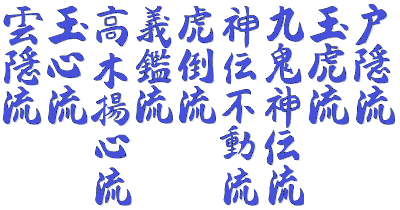|
bujinkan traditions
By Joe Maurantonio

There are nine main martial traditions that comprise the
Bujinkan Dojo training:
Togakure Ryu
Was founded by Diasuke Nishina who was raised as a vassal of Kiso Yoshinaka in
the early 12th century. When Yoshinaka's army was defeated in battle, Diasuke
escaped to Iga. There he learned various martial skills such as kosshijutsu and
kenjutsu from Kagakure Doshi. It was initially called Togakure Ryu Happo Biken
but has been called by various names since that time. Togakure Ryu is known for
its use of tekko, senban nage and shinodake (4-foot breathing
tube).
Gyokko Ryu
It is believed that a Chinese person named Ikai introduced this art to Japan in
the 8th century. According to Hatsumi Sensei, that person could also be somebody
(kai) from a foreign (i) country. It is assumed that this kosshijutsu was
based on Chinese martial arts. Although kosshijutsu means "to be able to
knock down an enemy with one finger", it can also signify the "backbone" [spine]
of the martial arts.
Kukishinden Ryu
The founder of this tradition was Yakushimaru Kurando Takazane, a palace
guard of Emperor Godaigo in the 1330's. He was awarded the family name of Kuki
(nine demons) for his spirited fighting and rescue of the Emperor. In addition
to bo, yari, shuriken and unarmed fighting methods, this tradition is
well known for its bojutsu and kenjutsu. Due in part to the Kuki family's
activities as suigun (navy) they adapted a low fighting posture that
permitted better balance on turbulent waters. This tradition is related to
Kukishin Ryu which is well known for its bojutsu.
Shinden Fudo Ryu
This ryu was founded by Izumo Kanja Yoshiteru. A characteristic of this
ryu is its recognition of shizen ("natural") as the only necessary
posture of defense. However, in reality, a person imagines a posture of defense
in his mind and places himself on guard. This tradition has two sections of
fighting (dakentaijutsu & jutaijutsu) as well as the philosophy of
not drawing a sword unless absolutely necessary.
Koto Ryu
This art was founded in the middle of the 16th century by Toda Sankyo Ishinsai
who had learned Gyokko Ryu from Gyokkan, a Buddhist monk. Koppojutsu originally
came from ancient China and was also called Goho, which was characterized by its
use of hidden weapons. The first kanji of koppo (kotsu)
means bone, but can have the deeper meaning of "knack".
Gikan Ryu
Founded by Unryu Hangan Gikanbo, Daimyo of Kawachi Province. He developed this
art from his lessons in kosshijutsu. The lessons of this tradition are
almost totally unknown to the public and many of its secret techniques were
handed down from s�ke to s�ke only.
Takagi Yoshin Ryu
Traces its lineage back to the 16th century scroll Rinpo Hiden which was
studied by Ito Ki-i no Kami. This tradition was founded by Takagi Oriemon
Shigenobu. This art developed through the years and has strong links to Takeuchi
Ryu, Kukishin Ryu and Hontai Yoshin Ryu. This tradition teaches to always remain
calm and flexible like the willow.
Gyokushin Ryu
This art is a branch of kosshijutsu and was founded by Sasaki Goemon
Teruyoshi. Characteristics of this tradition include its unique usage of nawa
nage (rope throwing) and espionage techniques. The secrets of this tradition
have only been hinted about by the current grandmaster.
Kumogakure Ryu
This martial art was founded by Heinaizaemon Ienaga Iga (Kumogakure Hoshi) who
was also believed to be the originator of Iga Ryu Ninjutsu. The special skills
of this tradition include its use of the kamayari (sickle spear) and
kote uchi (forearm striking) techniques. Much of the training in this
tradition is said to be likened to the taijutsu and philosophies of
escape and evasion techniques in Togakure Ryu.
Other training:
As well as the above mentioned Bujinkan traditions our dojo training also
encompasses several other martial traditions as well. For instance, our
kusari fundo training comes from Masaaki Ryu, while our daisho sabaki
training comes from Takagi Yoshin Ryu, and our black belt level Shinken Gata
training is derived from the philosophies and strategies of samurai hundreds of
years ago. Some weapon training is derived from Kukishin Ryu and other ryu.
This article reprinted from the
www.Kihon.com, with the kind permission of
the author. |



